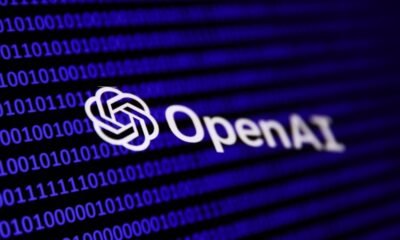AI Research
Attorneys general warn OpenAI ‘harm to children will not be tolerated’

California Attorney General Rob Bonta and Delaware Attorney General Kathy Jennings met with and sent an open letter to OpenAI to express their concerns over the safety of ChatGPT, particularly for children and teens.
The warning comes a week after Bonta and 44 other attorneys general sent a letter to 12 of the top AI companies, following reports of sexually inappropriate interactions between AI chatbots and children.
“Since the issuance of that letter, we learned of the heartbreaking death by suicide of one young Californian after he had prolonged interactions with an OpenAI chatbot, as well as a similarly disturbing murder-suicide in Connecticut,” Bonta and Jennings write. “Whatever safeguards were in place did not work.”
The two state officials are currently investigating OpenAI’s proposed restructuring into a for-profit entity to ensure that the mission of the nonprofit remains intact. That mission “includes ensuring that artificial intelligence is deployed safely” and building artificial general intelligence (AGI) to benefit all humanity, “including children,” per the letter.
“Before we get to benefiting, we need to ensure that adequate safety measures are in place to not harm,” the letter continues. “It is our shared view that OpenAI and the industry at large are not where they need to be in ensuring safety in AI products’ development and deployment. As Attorneys General, public safety is one of our core missions. As we continue our dialogue related to OpenAI’s recapitalization plan, we must work to accelerate and amplify safety as a governing force in the future of this powerful technology.”
Bonta and Jennings have asked for more information about OpenAI’s current safety precautions and governance, and said they expect the company to take immediate remedial measures where appropriate.
TechCrunch has reached out to OpenAI for comment.
Techcrunch event
San Francisco
|
October 27-29, 2025
AI Research
Training on AI, market research, raising capital offered through Jamestown Regional Entrepreneur Center – Jamestown Sun

Sevearl training events will be held for the public through the Jamestown Regional Entrepreneur Center in September.
On Sept. 9-12, a “Get Found Masterclass” will be offered to the public. This four-part workshop series is designed specifically for small business service providers who are focused on growth through smarter systems, trusted tools and clear visibility strategies. Across four focused sessions, participants will learn how to protect their brand while embracing automation, use Google’s free tools to enhance online visibility and send the right visibility signals to today’s AI-powered search engines. Participants will discover how AI can support small businesses, how to build ethical systems that scale, and what really influences trust, authority and ranking.
On Sept. 10, a stand-alone workshop on “Market and Customer Research” will be held. This workshop will guide participants on where and how to find customers. The presentation will
also discuss which SEO keywords competitors are using for free. Participants will compare current methods of social media marketing and discuss the variety of free market research tools that offer critical information on your industry and customers.
On Sept. 23, “AI tools for Social Media Marketing” is planned. Discuss the use of tools like ChatGPT to brainstorm post ideas, captions, and scripts; Lately.ai to repurpose long-form content into social media snippets; Canva + Magic Studio for fast, on-brand visuals and Metricool or later for AI-assisted scheduling and analytics. Automate so you can focus on connection and creativity.
On Sept. 24 is a high-level presentation led by Kat Steinberg, special counsel, and Amy Reischauer, deputy director of the of the Securities and Exchange Commision’s Office of the Advocate for Small Business Capital Formation, on the regulatory framework and SEC resources surrounding raising capital. They will also share broad data from their most recent annual report on what has been happening in capital raising in recent years. The office seeks to advocate and advance the interests of small businesses seeking to raise capital and the investors who support them at the SEC and in the capital markets. The office develops comprehensive educational materials and resources while actively engaging with
industry stakeholders to identify both obstacles and emerging opportunities in the capital
formation landscape. Through events like this, the office creates platforms for meaningful
dialogue, collecting valuable feedback and disseminating insights about capital-raising
pathways for small businesses from early-stage startups to established small public companies.
To register for these training events, visit www.JRECenter.com/Events. Follow the Jamestown
Regional Entrepreneur Center at Facebook.com/JRECenter, on Instagram at JRECenter and on
LinkedIn. Questions may be directed to Katherine.Roth@uj.edu.
AI Research
1 Brilliant Artificial Intelligence (AI) Stock Down 30% From Its All-Time High That’s a No-Brainer Buy

ASML is one of the world’s most critical companies.
Few companies’ products are as critical to the modern world’s technological infrastructure as those made by ASML (ASML 3.75%). Without the chipmaking equipment the Netherlands-based manufacturer provides, much of the world’s most innovative technology wouldn’t be possible. That makes it one of the most important companies in the world, even if many people have never heard of it.
Over the long term, ASML has been a profitable investment, but the stock has struggled recently — it’s down by more than 30% from the all-time high it touched in July 2024. I believe this pullback presents an excellent opportunity to buy shares of this key supporting player for the AI sector and other advanced technologies.
Image source: Getty Images.
ASML has been a victim of government policies around the globe
ASML makes lithography machines, which trace out the incredibly fine patterns of the circuits on silicon chips. Its top-of-the-line extreme ultraviolet (EUV) lithography machines are the only ones capable of printing the newest, most powerful, and most feature-dense chips. No other companies have been able to make EUV machines thus far. They are also highly regulated, as Western nations don’t want this technology going to China, so the Dutch and U.S. governments have put strict restrictions on the types of machines ASML can export to China or its allies. In fact, even tighter new regulations were put in place last year that prevented ASML from servicing some machines that it previously was allowed to sell to Chinese companies.
As a result of these export bans, ASML’s sales to one of the world’s largest economies have been curtailed. This led to investors bidding the stock down in 2024 — a drop it still hasn’t recovered from.
2025 has been a relatively strong year for ASML’s business, but tariffs have made it challenging to forecast where matters are headed. Management has been cautious with its guidance for the year as it is unsure of how tariffs will affect the business. In its Q2 report, management stated that tariffs had had a less significant impact in the quarter than initially projected. As a result, ASML generated 7.7 billion euros in sales, which was at the high end of its 7.2 billion to 7.7 billion euro guidance range. For Q3, the company says it expects sales of between 7.4 billion and 7.9 billion euros, but if tariffs have a significantly negative impact on the economic picture, it could come up short.
Given all the planned spending on new chip production capacity to meet AI-related demand, investors would be wise to assume that ASML will benefit. However, the company is staying conservative in its guidance even as it prepares for growth. This conservative stance has caused the market to remain fairly bearish on ASML’s outlook even as all signs point toward a strong 2026.
This makes ASML a buying opportunity at its current stock price.
ASML’s valuation hasn’t been this low since 2023
Compared to the last five years, ASML trades at a historically low price-to-earnings (P/E) ratio and a forward P/E ratio.
ASML PE Ratio data by YCharts.
With expectations for ASML at low levels, investors shouldn’t be surprised if its valuation rises sometime over the next year, particularly if management’s commentary becomes more bullish as demand increases in line with chipmakers’ efforts to expand their production capacity.
This could lift ASML back into its more normal valuation range in the mid-30s, which is perfectly acceptable given its growth level, considering that it has no direct competition.
ASML is a great stock to buy now and hold for several years or longer, allowing you to reap the benefits of chipmakers increasing their production capacity. Just because the market isn’t that bullish on ASML now, that doesn’t mean it won’t be in the future. This rare moment offers an ideal opportunity to load up on shares of a stock that I believe is one of the best values in the market right now.
AI Research
AI’s not ‘reasoning’ at all – how this team debunked the industry hype

Follow ZDNET: Add us as a preferred source on Google.
ZDNET’s key takeaways
- We don’t entirely know how AI works, so we ascribe magical powers to it.
- Claims that Gen AI can reason are a “brittle mirage.”
- We should always be specific about what AI is doing and avoid hyperbole.
Ever since artificial intelligence programs began impressing the general public, AI scholars have been making claims for the technology’s deeper significance, even asserting the prospect of human-like understanding.
Scholars wax philosophical because even the scientists who created AI models such as OpenAI’s GPT-5 don’t really understand how the programs work — not entirely.
Also: OpenAI’s Altman sees ‘superintelligence’ just around the corner – but he’s short on details
AI’s ‘black box’ and the hype machine
AI programs such as LLMs are infamously “black boxes.” They achieve a lot that is impressive, but for the most part, we cannot observe all that they are doing when they take an input, such as a prompt you type, and they produce an output, such as the college term paper you requested or the suggestion for your new novel.
In the breach, scientists have applied colloquial terms such as “reasoning” to describe the way the programs perform. In the process, they have either implied or outright asserted that the programs can “think,” “reason,” and “know” in the way that humans do.
In the past two years, the rhetoric has overtaken the science as AI executives have used hyperbole to twist what were simple engineering achievements.
Also: What is OpenAI’s GPT-5? Here’s everything you need to know about the company’s latest model
OpenAI’s press release last September announcing their o1 reasoning model stated that, “Similar to how a human may think for a long time before responding to a difficult question, o1 uses a chain of thought when attempting to solve a problem,” so that “o1 learns to hone its chain of thought and refine the strategies it uses.”
It was a short step from those anthropomorphizing assertions to all sorts of wild claims, such as OpenAI CEO Sam Altman’s comment, in June, that “We are past the event horizon; the takeoff has started. Humanity is close to building digital superintelligence.”
(Disclosure: Ziff Davis, ZDNET’s parent company, filed an April 2025 lawsuit against OpenAI, alleging it infringed Ziff Davis copyrights in training and operating its AI systems.)
The backlash of AI research
There is a backlash building, however, from AI scientists who are debunking the assumptions of human-like intelligence via rigorous technical scrutiny.
In a paper published last month on the arXiv pre-print server and not yet reviewed by peers, the authors — Chengshuai Zhao and colleagues at Arizona State University — took apart the reasoning claims through a simple experiment. What they concluded is that “chain-of-thought reasoning is a brittle mirage,” and it is “not a mechanism for genuine logical inference but rather a sophisticated form of structured pattern matching.”
Also: Sam Altman says the Singularity is imminent – here’s why
The term “chain of thought” (CoT) is commonly used to describe the verbose stream of output that you see when a large reasoning model, such as GPT-o1 or DeepSeek V1, shows you how it works through a problem before giving the final answer.
That stream of statements isn’t as deep or meaningful as it seems, write Zhao and team. “The empirical successes of CoT reasoning lead to the perception that large language models (LLMs) engage in deliberate inferential processes,” they write.
But, “An expanding body of analyses reveals that LLMs tend to rely on surface-level semantics and clues rather than logical procedures,” they explain. “LLMs construct superficial chains of logic based on learned token associations, often failing on tasks that deviate from commonsense heuristics or familiar templates.”
The term “chains of tokens” is a common way to refer to a series of elements input to an LLM, such as words or characters.
Testing what LLMs actually do
To test the hypothesis that LLMs are merely pattern-matching, not really reasoning, they trained OpenAI’s older, open-source LLM, GPT-2, from 2019, by starting from scratch, an approach they call “data alchemy.”
The model was trained from the beginning to just manipulate the 26 letters of the English alphabet, “A, B, C,…etc.” That simplified corpus lets Zhao and team test the LLM with a set of very simple tasks. All the tasks involve manipulating sequences of the letters, such as, for example, shifting every letter a certain number of places, so that “APPLE” becomes “EAPPL.”
Also: OpenAI CEO sees uphill struggle to GPT-5, potential for new kind of consumer hardware
Using the limited number of tokens, and limited tasks, Zhao and team vary which tasks the language model is exposed to in its training data versus which tasks are only seen when the finished model is tested, such as, “Shift each element by 13 places.” It’s a test of whether the language model can reason a way to perform even when confronted with new, never-before-seen tasks.
They found that when the tasks were not in the training data, the language model failed to achieve those tasks correctly using a chain of thought. The AI model tried to use tasks that were in its training data, and its “reasoning” sounds good, but the answer it generated was wrong.
As Zhao and team put it, “LLMs try to generalize the reasoning paths based on the most similar ones […] seen during training, which leads to correct reasoning paths, yet incorrect answers.”
Specificity to counter the hype
The authors draw some lessons.
First: “Guard against over-reliance and false confidence,” they advise, because “the ability of LLMs to produce ‘fluent nonsense’ — plausible but logically flawed reasoning chains — can be more deceptive and damaging than an outright incorrect answer, as it projects a false aura of dependability.”
Also, try out tasks that are explicitly not likely to have been contained in the training data so that the AI model will be stress-tested.
Also: Why GPT-5’s rocky rollout is the reality check we needed on superintelligence hype
What’s important about Zhao and team’s approach is that it cuts through the hyperbole and takes us back to the basics of understanding what exactly AI is doing.
When the original research on chain-of-thought, “Chain-of-Thought Prompting Elicits Reasoning in Large Language Models,” was performed by Jason Wei and colleagues at Google’s Google Brain team in 2022 — research that has since been cited more than 10,000 times — the authors made no claims about actual reasoning.
Wei and team noticed that prompting an LLM to list the steps in a problem, such as an arithmetic word problem (“If there are 10 cookies in the jar, and Sally takes out one, how many are left in the jar?”) tended to lead to more correct solutions, on average.
They were careful not to assert human-like abilities. “Although chain of thought emulates the thought processes of human reasoners, this does not answer whether the neural network is actually ‘reasoning,’ which we leave as an open question,” they wrote at the time.
Also: Will AI think like humans? We’re not even close – and we’re asking the wrong question
Since then, Altman’s claims and various press releases from AI promoters have increasingly emphasized the human-like nature of reasoning using casual and sloppy rhetoric that doesn’t respect Wei and team’s purely technical description.
Zhao and team’s work is a reminder that we should be specific, not superstitious, about what the machine is really doing, and avoid hyperbolic claims.
-

 Business1 week ago
Business1 week agoThe Guardian view on Trump and the Fed: independence is no substitute for accountability | Editorial
-
Tools & Platforms4 weeks ago
Building Trust in Military AI Starts with Opening the Black Box – War on the Rocks
-

 Ethics & Policy1 month ago
Ethics & Policy1 month agoSDAIA Supports Saudi Arabia’s Leadership in Shaping Global AI Ethics, Policy, and Research – وكالة الأنباء السعودية
-

 Events & Conferences4 months ago
Events & Conferences4 months agoJourney to 1000 models: Scaling Instagram’s recommendation system
-

 Jobs & Careers2 months ago
Jobs & Careers2 months agoMumbai-based Perplexity Alternative Has 60k+ Users Without Funding
-

 Education2 months ago
Education2 months agoVEX Robotics launches AI-powered classroom robotics system
-

 Podcasts & Talks2 months ago
Podcasts & Talks2 months agoHappy 4th of July! 🎆 Made with Veo 3 in Gemini
-

 Funding & Business2 months ago
Funding & Business2 months agoKayak and Expedia race to build AI travel agents that turn social posts into itineraries
-

 Education2 months ago
Education2 months agoMacron says UK and France have duty to tackle illegal migration ‘with humanity, solidarity and firmness’ – UK politics live | Politics
-

 Podcasts & Talks2 months ago
Podcasts & Talks2 months agoOpenAI 🤝 @teamganassi






















